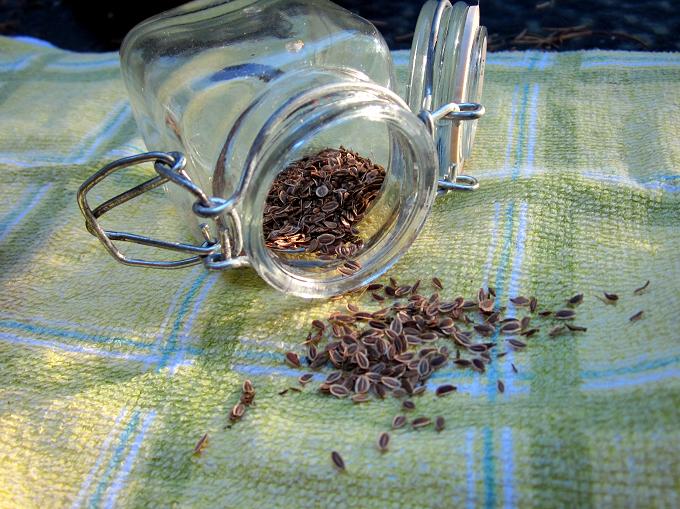 “Still alive I am.
At the end of a long dream.
On my journey,
fall of an Autumn day.”
“Still alive I am.
At the end of a long dream.
On my journey,
fall of an Autumn day.”
– Matsuo Bashō, The records of a weather-exposed skeleton (1684)
I sit in my living room, coffee in hand with the fire from the wood stove sputtering and popping behind me, toasty and content, while outside my austere little zen garden shivers and rots in the autumn frost… It’s all gone to seed.
The chilly mornings are shriveling the last of the stubborn green tomatoes, the rains have splattered my brand new sorrel in dirt soup and nearby cedar trees have smothered the raised beds in a quilt of brown and red leaves. There is little left to harvest vegetable-wise aside from one or two carrots and some kale sulking over in the corner… It’s quiet, like an empty concert hall.
Show’s over folks, time to go on home!
And I’m the guy with the push-broom cleaning up… So, I finish my coffee and get to work. Pick all those green tomatoes, salvage what carrots and beets that remain, slash away all the dead mulch, rake leaves and collect seeds.
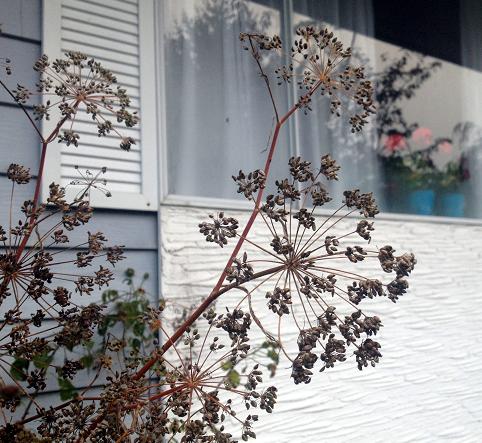 The once brilliant green stalks of fennel, caraway and dill that I planted in the early summer have browned, and will soon rot away under the relentless rain of a BC winter. I’m not one to let anything go to waste (especially something I can eat!) so I’ve gotten into the habit of collecting the seeds from these herbs and either saving them to re-plant next spring, or drying them for culinary use. These plants are all members of the Apiaceae (carrot or parsley) family and share a couple of traits in common that make ‘em simple to harvest.
The once brilliant green stalks of fennel, caraway and dill that I planted in the early summer have browned, and will soon rot away under the relentless rain of a BC winter. I’m not one to let anything go to waste (especially something I can eat!) so I’ve gotten into the habit of collecting the seeds from these herbs and either saving them to re-plant next spring, or drying them for culinary use. These plants are all members of the Apiaceae (carrot or parsley) family and share a couple of traits in common that make ‘em simple to harvest.
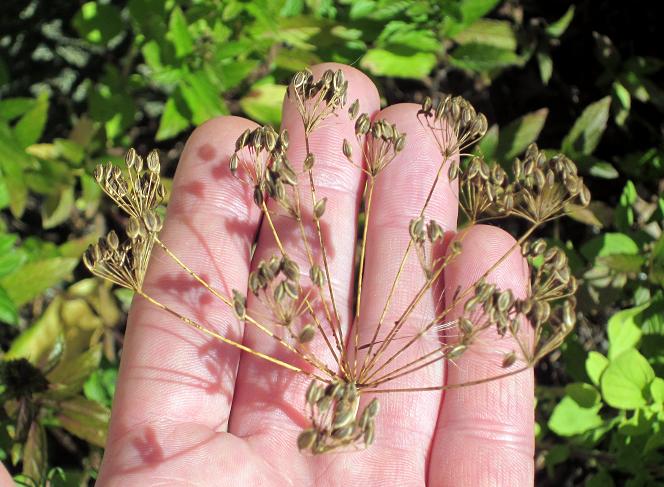 As I’ve already mentioned, their long stems will begin to turn golden in early September and by October any part of the plant that is ready to harvest will be a deep reddish-brown from flower to stalk. By now the flowers have shriveled up and revealed the seed pods, all ready to parachute into the garden and start new plants. Avoid any flowers that look rotted or discoloured (it means the moisture has already gotten to them) or that are cocooned in spider webs (someone obviously lives there!). Moisture will only really be a problem for plants that are close to the ground like my caraway plant, the fennel on the other hand towers over the garden and stays pretty dry.
As I’ve already mentioned, their long stems will begin to turn golden in early September and by October any part of the plant that is ready to harvest will be a deep reddish-brown from flower to stalk. By now the flowers have shriveled up and revealed the seed pods, all ready to parachute into the garden and start new plants. Avoid any flowers that look rotted or discoloured (it means the moisture has already gotten to them) or that are cocooned in spider webs (someone obviously lives there!). Moisture will only really be a problem for plants that are close to the ground like my caraway plant, the fennel on the other hand towers over the garden and stays pretty dry.
The stems are hollow and very easy to clip off with a sharp knife or pair of scissors. Cut an inch below the flowers and toss the whole thing into a large paper bag. Fill the paper bag up about half way and then open up another one. We want the flowers to dry loosely-packed to avoid damage and moulding.
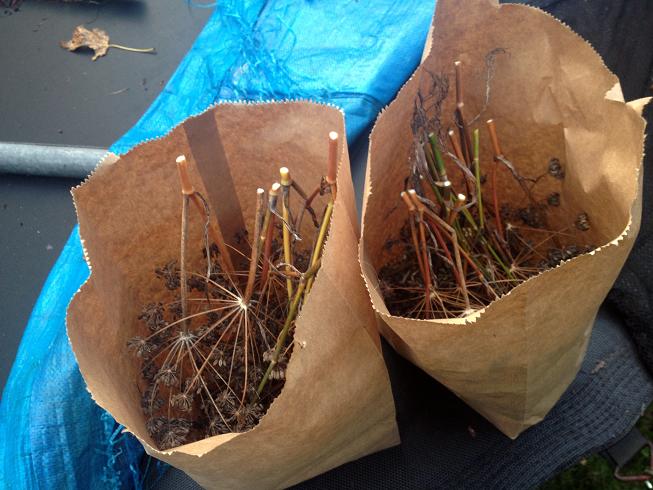 Store your bags ‘o flowers in a cool dry spot indoors and give ‘em a shake every so often to loosen the seeds. Don’t they smell awesome!? After a week or two it’s a simple matter to scrunch the flowers with your hands and shake the seeds into a bowl. Don’t forget the ones hiding in the folds of the bag! Separate the seeds from the stems and other bits and pop them into a glass container. They’ll last all winter long and can be used in a variety of recipes and cooking techniques:
Store your bags ‘o flowers in a cool dry spot indoors and give ‘em a shake every so often to loosen the seeds. Don’t they smell awesome!? After a week or two it’s a simple matter to scrunch the flowers with your hands and shake the seeds into a bowl. Don’t forget the ones hiding in the folds of the bag! Separate the seeds from the stems and other bits and pop them into a glass container. They’ll last all winter long and can be used in a variety of recipes and cooking techniques:
Fennel Seeds – Soft and licorice-like, this aromatic spice plays well in both sweet and savoury dishes, especially when blended with other, more assertive spices. It’s an essential part of many spice mixtures like Panch phoran, Biryani Masala, Chinese Five Spice, and authentic Indian Chai. A killer flavouring agent for oils, custards and syrups and they find their way into many bread and dessert recipes. Fennel is the reason why you love Italian sausage so much!
Caraway Seeds – Caraway is absolutely my favourite spice, and one that never gets much love. Unlike fennel, it’s assertive and sharp in flavour and aroma and doesn’t play well with other spices. It’s used extensively in German and Scandinavian cuisine, notably in bread, pickling and preserving recipes. It’s a great flavour to enhance mild cheeses like Havarti or Gouda and hard alcohol such as Aquavit and Kümmel.
Dill Seeds – Probably best known as a pickling spice, dill seeds are a pungent ‘n tangy addition to many recipes and cooking styles. Dill is a staple of Mediterranean cuisine, absolutely killing it with seafood, breads, pulses and marinated veg. Dill-infused oils and vinegars are great for salads, antipasto (or I suppose around the Aegean they’d say “mezzes”) and slaw. Warm potato salad with dill seed is life-changing.
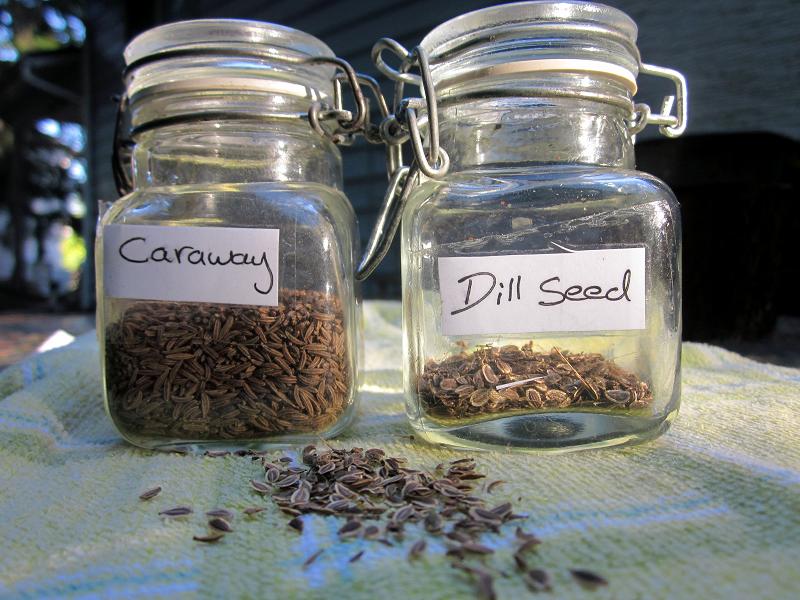
Am sitting at Slowick’s computer in south Florida (Englewood) after spending the weekend at Palm Island resort along one of the Gulf of Mexico beaches . It is like some sort of fantasy world that I am reading your blog about gathering the seeds as your winter season approaches when we have yesterday spent a glorious day in the sun.
The information in this blog is most useful to those of us who have little or no experience in these matters. It is a good reference. Keep it coming. Judy
What kind of seeds do they store in south Florida ? *laughs*
Glad to hear that you are enjoying the good weather down south, and that you get a bit of know-how out of my ramblings.
I’ve learned so much this season from careful observation of the climate/plant relationship and a ton of trial and error!
Where’s the pumpkin seed 1-0-1?
Great idea! We just picked up two monster pumpkins from the local Mega-Lo-Mart!
I haven’t decided what to carve this year… Any suggestions for designs? And what to do with the seeds?
I have never carved a pumpkin – hard to believe but true 🙂 We’ve put ours out whole as Bruce isn’t into carving either.